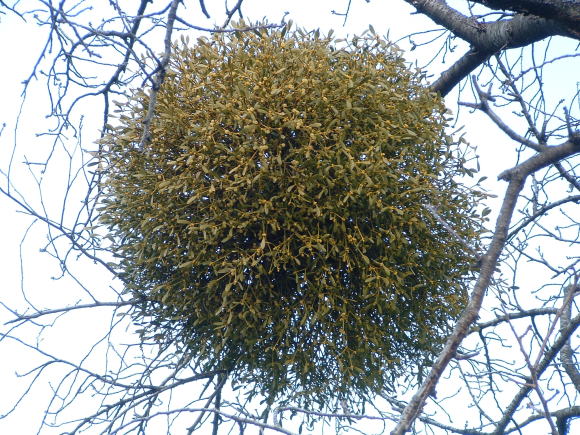
Japanese mistletoe (yadorigi) - the berries are yellowish rather than white
No, mistletoe doesn’t feature in Shinto, but it’s an important part of the European pagan tradition at this time of year. Here naturalist Kevin Short takes a seasonal look at the folklore of mistletoe in Europe, prompting thoughts about the commonality of nature religions. (For the full Japan Times article, click here.)
****************************************
European mistletoe is a branching evergreen shrub with thin leaves that attach in opposing pairs at each node of the branch. Small yellow flowers bloom at the tip of the branch in very early spring, in the crotch between the leaves. The fruits, small milky white berries, mature from early to mid-winter.
Mistletoe berries are poisonous to humans, but are eaten by birds. The seeds are coated with thick mucus that allows them to stick solidly when wiped off or excreted onto tree branches. The mucus later hardens, and when the seed germinates it sends out a special tap root that penetrates right into the branch of the host tree, where it funnels up water and mineral nutrients to the mistletoe leaves.
Mistletoe has since antiquity been considered a sacred plant in Celtic, Nordic and other European cultural traditions. The first-century Roman soldier and natural historian Pliny the Elder described a ceremony in which Celtic druids climbed up an oak tree to cut down sprigs of mistletoe using a golden sickle. The falling mistletoe was caught in a blanket by people waiting under the tree, and two white bulls were slaughtered as a sacrifice. The mistletoe appears to have been used in ceremonies conducted to ensure the fertility of domestic livestock. The milky white berries may have been symbolic of male sperm and fertility.

Even today, sprigs of mistletoe are widely used as decorations during the Yuletide or Christmas season. According to tradition, girls caught standing under the mistletoe may be kissed. This custom may have some base in the plant’s deep association with fertility in the Celtic tradition. Another theory is that the custom actually derives from Scandinavian mythology.
Baldur, son of Odin and Frigg, was a gentle handsome youth with a sunny disposition. A seer, however, foretold that he would be killed by a wooden spear or dagger. Frigg, anxious to protect her darling son, traveled all over the nine worlds of Norse cosmology, extracting promises from all the trees never to harm him. Unfortunately, she somehow bypassed the mistletoe. The evil trickster Loki, jealous of Baldur’s good looks and popularity, learned of this, and had the boy killed with a shaft made from mistletoe wood.
In the classic Norse myth mistletoe is responsible for the death of the peaceful Baldur. In later popular folklore, however, mistletoe conversely became associated with love and good will. Enemies that found themselves dueling under a mistletoe shrub were required to make peace; while lovers who embraced under the shrub were assured a long, happy and fertile married life.

Leave a Reply